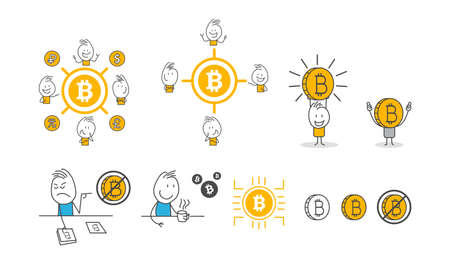1. Introduction: The Growing Role of Altcoins
Over the past decade, altcoins have emerged as a crucial part of the cryptocurrency ecosystem. While Bitcoin remains the most well-known and widely adopted digital asset, alternative cryptocurrencies like Ethereum, Litecoin, and many others have carved out their own unique roles in the market.
The Evolution of Altcoins
Altcoins, or “alternative coins,” were initially created to address some of Bitcoin’s limitations, such as transaction speed and scalability. Over time, these cryptocurrencies have evolved into much more than just Bitcoin alternatives. They now serve various purposes, including smart contracts, decentralized finance (DeFi), privacy-focused transactions, and enterprise blockchain solutions.
(1) Early Altcoins
The first wave of altcoins primarily aimed to improve upon Bitcoin’s design. Litecoin, for example, was launched in 2011 with faster block times and a different hashing algorithm to enhance transaction efficiency.
(2) Smart Contract Revolution
Ethereum introduced smart contracts in 2015, enabling developers to create decentralized applications (dApps). This innovation paved the way for DeFi projects and non-fungible tokens (NFTs), significantly expanding the use cases of blockchain technology.
(3) Recent Developments
More recently, newer altcoins have focused on enhancing scalability, energy efficiency, and interoperability between different blockchains. Projects like Solana and Polkadot aim to solve existing blockchain bottlenecks while providing new functionalities for users and developers.
The Increasing Significance of Altcoins
As the cryptocurrency market matures, altcoins are playing a growing role in shaping the future of digital finance. Here are some key reasons why they have become increasingly important:
| Factor | Impact on Altcoins |
|---|---|
| Diversification | Investors are looking beyond Bitcoin to diversify their crypto portfolios with assets that offer unique utilities. |
| Innovation | Many altcoins introduce new technologies that improve upon Bitcoin’s limitations or create entirely new use cases. |
| Institutional Interest | Larger financial institutions are exploring altcoins for investment and business applications. |
| Mainstream Adoption | Certain altcoins are gaining traction in industries such as gaming, supply chain management, and finance. |
The rapid growth and adoption of altcoins indicate that they will continue to shape the future of cryptocurrency. As we explore specific predictions for Ethereum, Litecoin, and other popular cryptos in the following sections, it is essential to understand how these digital assets contribute to the evolving landscape of blockchain technology.
2. Ethereum: The Future of Smart Contracts and DeFi
Examining Ethereum’s Growth
Ethereum has come a long way since its launch in 2015. As the first blockchain to introduce smart contracts, it revolutionized the crypto industry by enabling decentralized applications (dApps). Over the years, Ethereum has seen widespread adoption across various industries, including finance, gaming, and supply chain management.
(1) Adoption and Market Performance
Ethereum remains the second-largest cryptocurrency by market capitalization, only behind Bitcoin. Its strong developer community and continuous upgrades have helped maintain its dominance in the altcoin space.
| Year | Ethereum Price (Approx.) | Key Developments |
|---|---|---|
| 2015 | $0.75 | Mainnet launch |
| 2017 | $700+ | ICO boom driven by Ethereum |
| 2020 | $600+ | Rise of DeFi projects |
| 2021 | $4,800+ | NFT explosion on Ethereum network |
| 2023 | $1,500 – $2,000 | EIP-1559 & transition toward Ethereum 2.0 |
The Impact of Ethereum 2.0
The transition to Ethereum 2.0 is one of the most anticipated upgrades in the crypto space. By moving from a Proof-of-Work (PoW) to a Proof-of-Stake (PoS) consensus mechanism, Ethereum aims to improve scalability, security, and sustainability.
(1) Key Features of Ethereum 2.0
- Proof-of-Stake (PoS): Reduces energy consumption and makes transactions faster.
- Sharding: Increases network capacity by splitting data processing into smaller pieces.
- EIP-1559: Introduces a new fee-burning mechanism to make ETH deflationary over time.
- Sustainability: Lower energy usage compared to traditional mining.
(2) Potential Challenges
- User Migration: dApps and projects need to adapt to the new PoS system.
- Centralization Risks: Staking may lead to concentration of power among large validators.
- Ecosystem Adjustments: Developers must update smart contracts for full compatibility with Ethereum 2.0.
The Role of Ethereum in DeFi and NFTs
No other blockchain has had a greater impact on decentralized finance (DeFi) than Ethereum. The majority of DeFi applications, including lending platforms, decentralized exchanges (DEXs), and stablecoins, run on Ethereums network.
(1) Growth of DeFi on Ethereum
The total value locked (TVL) in DeFi protocols has skyrocketed over recent years. Projects like Uniswap, Aave, and Compound continue to dominate the space, offering decentralized financial services without intermediaries.
| Year | Total Value Locked (TVL) |
|---|---|
| 2019 | $1 billion+ |
| 2020 | $15 billion+ |
| 2021 | $100 billion+ |
| 2023 | $50 – $60 billion (Fluctuating) |
(2) NFTs and Digital Ownership
The rise of non-fungible tokens (NFTs) has further solidified Ethereum’s importance in the digital economy. Platforms like OpenSea, Rarible, and Foundation rely on Ethereum’s ERC-721 standard for NFT creation and trading.
- Cultural Shift: Artists and creators can now monetize digital assets like never before.
- Mainstream Adoption: Celebrities, brands, and even traditional companies are joining the NFT movement.
- Potential Issues: High gas fees remain a challenge for smaller creators looking to mint NFTs affordably.
The future looks bright for Ethereum as it continues to evolve with technological advancements and increasing adoption across multiple sectors.

3. Litecoin: Digital Silver’s Position in the Market
Litecoin (LTC) has long been referred to as the “silver to Bitcoin’s gold.” Created by Charlie Lee in 2011, Litecoin was designed to offer faster transactions and lower fees compared to Bitcoin (BTC). Over the years, it has maintained a strong presence in the cryptocurrency market, serving as a reliable transactional digital asset.
How Litecoin Compares to Bitcoin
While Litecoin and Bitcoin share many similarities, they also have key differences that set them apart. Below is a comparison of their core features:
| Feature | Litecoin (LTC) | Bitcoin (BTC) |
|---|---|---|
| Block Time | 2.5 minutes | 10 minutes |
| Total Supply | 84 million LTC | 21 million BTC |
| Transaction Fees | Lower than Bitcoin | Higher due to network demand |
| Main Use Case | P2P transactions, payments | Store of value, large transactions |
| Mining Algorithm | Scrypt | SHA-256 |
The Role of Litecoin in Digital Payments
LTC is widely used for everyday transactions thanks to its fast confirmation times and low transaction costs. Many merchants accept Litecoin as payment, making it a practical alternative to Bitcoin for day-to-day spending.
(1) Faster Transactions
The shorter block time of Litecoin enables quicker transaction confirmations, making it more suitable for real-world purchases compared to Bitcoin.
(2) Lower Fees
The cost of sending LTC is significantly lower than BTC, especially during periods of high network congestion. This makes it an attractive option for microtransactions.
(3) Adoption by Businesses and Platforms
An increasing number of online retailers and payment processors support Litecoin, further solidifying its role as a transactional cryptocurrency.
The Future Outlook for Litecoin
The future of Litecoin looks promising as developers continue working on improvements such as MimbleWimble integration for enhanced privacy. Additionally, its strong community support ensures ongoing adoption and use in the crypto space.
(1) Privacy Enhancements with MimbleWimble
MimbleWimble technology aims to improve Litecoin’s privacy features, making transactions more secure while maintaining efficiency.
(2) Institutional Interest
LTC has gained attention from institutional investors looking for alternative assets beyond Bitcoin and Ethereum.
(3) Increasing Real-World Use Cases
LTCs utility in payments may expand further with more businesses adopting crypto-friendly payment systems.
The combination of speed, affordability, and widespread adoption keeps Litecoin relevant in the evolving crypto landscape.
4. Rising Stars: Emerging Altcoins to Watch
While established cryptocurrencies like Ethereum and Litecoin continue to dominate the market, several emerging altcoins show great promise. These rising stars offer strong fundamentals, unique use cases, and significant growth potential. Let’s take a closer look at some of the most promising emerging altcoins.
(1) Solana (SOL)
Solana has gained attention for its high-speed transactions and low fees, making it a strong competitor in the blockchain space. With its scalability and growing ecosystem of decentralized applications (dApps), Solana is positioning itself as a top choice for developers.
(2) Avalanche (AVAX)
Avalanche is another high-performance blockchain that offers fast transaction speeds and strong security. Its ability to support multiple blockchains within its ecosystem makes it an attractive option for enterprises and developers looking for scalable solutions.
(3) Polkadot (DOT)
Polkadot enables interoperability between different blockchains, allowing them to communicate and share data seamlessly. This feature makes Polkadot a vital player in the future of decentralized finance (DeFi) and blockchain innovation.
(4) Algorand (ALGO)
Algorand focuses on speed, security, and decentralization. Its pure proof-of-stake (PPoS) consensus mechanism ensures efficient transactions while minimizing energy consumption, making it an eco-friendly blockchain solution.
(5) Chainlink (LINK)
Chainlink plays a crucial role in enabling smart contracts to interact with real-world data. Its decentralized oracle network enhances blockchain functionality by connecting smart contracts with external information such as price feeds, weather data, and more.
Comparison of Emerging Altcoins
| Altcoin | Key Feature | Main Use Case |
|---|---|---|
| Solana (SOL) | High-speed transactions | dApps & DeFi |
| Avalanche (AVAX) | Scalable multi-chain network | Enterprise & DeFi |
| Polkadot (DOT) | Blockchain interoperability | Cross-chain communication |
| Algorand (ALGO) | Eco-friendly PPoS system | Sustainable finance & payments |
| Chainlink (LINK) | Decentralized oracles | Smart contract integration |
The cryptocurrency market continues to evolve, and these emerging altcoins are paving the way for new innovations. By offering unique solutions and addressing key challenges in the blockchain space, these projects have the potential to grow significantly in the coming years.
5. Challenges and Risks in the Altcoin Market
Investing in altcoins can be exciting, but it also comes with its fair share of challenges and risks. Before jumping into the market, investors should carefully evaluate factors such as regulatory concerns, market volatility, and overall investment strategies.
Regulatory Concerns
One of the biggest uncertainties in the altcoin market is regulation. Governments around the world are still figuring out how to manage cryptocurrencies, leading to potential legal changes that could impact investors.
(1) Government Regulations
- Some countries have embraced crypto-friendly regulations, while others have imposed strict bans.
- The U.S. Securities and Exchange Commission (SEC) has increased its scrutiny of certain altcoins, potentially classifying them as securities.
- New laws or restrictions could affect liquidity and trading options for specific cryptocurrencies.
(2) Tax Implications
- Crypto transactions may be subject to capital gains tax in many jurisdictions.
- Lack of clear tax guidelines can create confusion for investors when reporting their earnings.
- Keeping track of transactions for tax purposes can be complex and time-consuming.
Market Volatility
The altcoin market is known for its extreme price fluctuations. While this volatility presents opportunities for profit, it also increases the risk of sudden losses.
| Factor | Impact on Altcoins |
|---|---|
| High Price Swings | Dramatic price movements can lead to quick gains or steep losses within hours. |
| Lack of Liquidity | Smaller altcoins may experience low trading volume, making it difficult to buy or sell without affecting prices. |
| Market Speculation | Meme coins and hype-driven projects can cause unpredictable surges and crashes. |
Factors Investors Should Consider
If youre thinking about investing in altcoins, its important to analyze various factors before making a decision.
(1) Project Fundamentals
- Research the team behind the project and their track record in the industry.
- Understand the use case and real-world application of the cryptocurrency.
- Avoid projects that lack transparency or have unclear roadmaps.
(2) Security Risks
- The rise of scams and rug pulls makes it essential to verify the legitimacy of an altcoin project.
- Sophisticated cyberattacks on exchanges and wallets could result in loss of funds.
- Avoid storing large amounts of crypto on centralized platforms without proper security measures.
(3) Diversification Strategy
- Avoid putting all your investments into a single altcoin—diversification helps reduce risk.
- A balanced portfolio should include a mix of established cryptos like Ethereum and smaller promising projects.
- Keeps some funds liquid in case of sudden opportunities or downturns in the market.
Navigating the altcoin market requires careful consideration of these risks. By staying informed and making calculated decisions, investors can better position themselves for success while mitigating potential downsides.
6. Conclusion: What’s Next for the Altcoin Market?
The world of altcoins is evolving rapidly, with new projects and innovations shaping the future of digital assets. While Ethereum, Litecoin, and other popular cryptocurrencies continue to dominate the space, market trends and technological advancements will play a crucial role in their trajectory.
Key Factors Influencing the Future
Several factors will determine how the altcoin market develops in the coming years:
- Regulation: Governments and financial institutions are working on clearer regulations that could either boost or hinder altcoin adoption.
- Institutional Investment: More businesses and financial firms are exploring cryptocurrency investments, potentially driving demand for established altcoins.
- Blockchain Innovations: Upgrades like Ethereum’s scalability solutions and Litecoin’s privacy enhancements may impact their long-term success.
- Market Sentiment: Public perception and mainstream adoption will continue to influence price trends and overall market dynamics.
Potential Trends in the Altcoin Market
The following trends could shape the future of altcoins:
| Trend | Description |
|---|---|
| Layer-2 Solutions | Scaling solutions like Ethereum’s Layer-2 networks aim to reduce transaction fees and increase speed. |
| Decentralized Finance (DeFi) Growth | The expansion of DeFi platforms could drive greater demand for altcoins as financial alternatives. |
| Interoperability | Projects focusing on cross-chain compatibility may gain traction as users seek seamless transactions between blockchains. |
| Sustainability Initiatives | A shift towards energy-efficient consensus mechanisms like Proof-of-Stake (PoS) could impact which projects succeed. |
The Road Ahead for Investors
If you’re considering investing in altcoins, here are some key points to keep in mind:
(1) Stay Updated on Market Trends
The crypto landscape changes quickly. Following news on regulatory updates, technological developments, and major partnerships can help you make informed decisions.
(2) Diversify Your Portfolio
Diversification can help mitigate risks. Instead of focusing solely on one cryptocurrency, consider spreading investments across multiple promising projects.
(3) Understand Volatility Risks
The altcoin market is known for its price swings. Be prepared for potential fluctuations and invest only what you can afford to lose.


